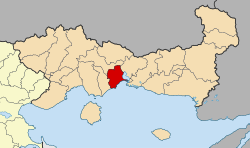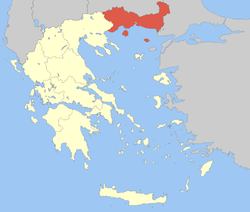Abdera, Thrace
| Abdera Άβδηρα | |
|---|---|
|
Remains of the ancient city of Abdera. | |
 Abdera Location within the region  | |
| Coordinates: 40°56′N 24°58′E / 40.933°N 24.967°ECoordinates: 40°56′N 24°58′E / 40.933°N 24.967°E | |
| Country | Greece |
| Administrative region | East Macedonia and Thrace |
| Regional unit | Xanthi |
| Area | |
| • Municipality | 352.0 km2 (135.9 sq mi) |
| • Municipal unit | 162.0 km2 (62.5 sq mi) |
| Elevation | 41 m (135 ft) |
| Population (2011)[1] | |
| • Municipality | 19,005 |
| • Municipality density | 54/km2 (140/sq mi) |
| • Municipal unit | 3,341 |
| • Municipal unit density | 21/km2 (53/sq mi) |
| Community[1] | |
| • Population | 1,473 (2011) |
| Time zone | UTC+2 (EET) |
| • Summer (DST) | UTC+3 (EEST) |
| Vehicle registration | AH |
Abdera (/əbˈdɪərə/; (Ancient Greek: Ἄβδηρα, τὰ Ἄβδηρα, Ἄβδηρον Ἄβδηρος); Latin: Abdera, Abderorum)[2] is a municipality and a former major Greek polis on the coast of Thrace. It lay 17 km east-northeast of the mouth of the Nestos River, almost directly opposite the island of Thasos. The site now lies in the Xanthi regional unit of Thrace, Greece. The municipality of Abdera (Modern Greek: Άβδηρα [ˈavðira]) has 19,005 inhabitants (2011). The seat of the municipality is the town Genisea.[3]
History


Its mythical foundation was attributed to Heracles who founded the city on behalf of his fallen friend Abderus.[4] The historical founding is traced back to a colony from Klazomenai. This historical founding was traditionally dated to 654 BCE, which is unverified, although evidence in 7th century BCE Greek pottery tends to support it.[5] But its prosperity dates from 544 BC, when the majority of the people of Teos (including the poet Anacreon) migrated to Abdera to escape the Persian yoke (Herodotus i.168).[6] The chief coin type, a griffon, is identical with that of Teos; the rich silver coinage is noted for the beauty and variety of its reverse types.[7]
In 513 BCE and 512 BCE, the Persians, under Xerxes conquered Abdera, by which time the city seems to have become a place of considerable importance, and is mentioned as one of the cities which had the expensive honour of entertaining the great king on his march into Greece.[8] On his flight after the Battle of Salamis, Xerxes stopped at Abdera and acknowledged the hospitality of its inhabitants by presenting them with a tiara and scimitar of gold.[9] In 496 BCE, the Persians again conquered Abdera, this time under Darius I. Thucydides[10] mentions Abdera as the westernmost limit of the Odrysian kingdom when at its height at the beginning of the Peloponnesian war. It later became part of the Delian League and fought on the side of Athens in the Peloponnesian war.[11]
Abdera was a wealthy city, the third richest in the League, due to its status as a prime port for trade with the interior of Thrace and the Odrysian kingdom.[5] In 408 BCE, Abdera was reduced under the power of Athens by Thrasybulus, then one of the Athenian generals in that quarter.[12]
A valuable prize, the city was repeatedly sacked: by the Triballi in 376 BCE, Philip II of Macedon in 350 BCE; later by Lysimachos of Thrace,[6] the Seleucids, the Ptolemies, and again by the Macedonians. In 170 BCE the Roman armies and those of Eumenes II of Pergamon besieged and sacked it.
The town seems to have declined in importance after the middle of the 4th century BCE.[7] Cicero ridicules the city as a byword for stupidity in his letters to Atticus, writing of a debate in the Senate, "Here was Abdera, but I wasn't silent" ("Hic, Abdera non tacente me").[13] Nevertheless, the city counted among its citizens the philosophers Democritus, Protagoras[6] and Anaxarchus, historian and philosopher Hecataeus of Abdera, and the lyric poet Anacreon. Pliny the Elder speaks of Abdera as being in his time a free city.[14]

Abdera had flourished especially in ancient times mainly for two reasons: because of the large area of their territory and their highly strategic position. The city controlled two great road passages (one of Nestos river and other through the mountains north of Xanthi). Furthermore, from their ports passed the sea road, which from Troas led to the Thracian and then the Macedonian coast.[15]
The ruins of the town may still be seen on Cape Balastra (40°56'1.02"N 24°58'21.81"E); they cover seven small hills, and extend from an eastern to a western harbor; on the southwestern hills are the remains of the medieval settlement of Polystylon.[7]
Municipality
The municipality Abdera was formed at the 2011 local government reform by the merger of three former municipalities that became municipal units: Abdera, Selero, and Vistonida.[16]
The municipality has an area of 352.047 km2, the municipal unit 161.958 km2.[17] The municipal unit Abdera is subdivided into the communities Abdera, Mandra, Myrodato and Nea Kessani. The community Abdera consists of the settlements Abdera, Giona, Lefkippos, Pezoula and Skala.
Landmarks
Landmarks of Abdera include the Archaeological Museum of Abdera, and Agios Ioannis Beach (also Paralia Avdiron) near the village Lefkippos.
Famous people
References
- 1 2 "Απογραφή Πληθυσμού - Κατοικιών 2011. ΜΟΝΙΜΟΣ Πληθυσμός" (in Greek). Hellenic Statistical Authority.
- ↑

- ↑ "Administrative changes in OTA". EETAA. 4 December 1997. Archived from the original on 2016-12-12. Retrieved 9 December 2016.
- ↑ Pseudo-Apollodorus, Bibliotheca, ed. Wagner, R. Leipzig: Teubner, 1894; Mythographi Graeci 1, Chapter 2, section 97, line 7ff.
- 1 2 Hornblower, Simon (1996). "Abdera". The Oxford Classical Dictionary. Oxford: Oxford University Press. p. 1.
- 1 2 3 "Abdera". Encyclopædia Britannica. I: A-Ak - Bayes (15th ed.). Chicago, IL: Encyclopædia Britannica, Inc. 2010. p. 19. ISBN 978-1-59339-837-8.
- 1 2 3

- Mittheil. d. deutsch. Inst. Athens, xii. (1887), p. 161 (Regel);
- Mém. de l'Acad. des Inscriptions, xxxix. 211;
- K. F. Hermann, Ges. Abh. 90-111, 370 ff.
- ↑ Herod. vii. 120.
- ↑

- ↑ ii. 97.
- ↑ Diodorus Siculus, Bibliotheca historica, ed. Vogel, F., Fischer, K.T. (post I. Bekker & L. Dindorf), Leipzig: Teubner, 1:1888; 2:1890; 3:1893; 4–5:1906, Repr. 1964. Book 13, chapter 72, section 2, line 2.
- ↑ Diod. xiii. 72.
- ↑ Cicero. Epistulae ad Atticum, 4.17.3, 7.7.4.
- ↑ N.H. iv. 18.
- ↑ D. C. Samsaris, Historical Geography of Western Thrace during the Roman Antiquity (in Greek), Thessaloniki 2005, p. 91-96
- ↑ Kallikratis law Greece Ministry of Interior (in Greek)
- ↑ "Population & housing census 2001 (incl. area and average elevation)" (PDF) (in Greek). National Statistical Service of Greece. Archived from the original (PDF) on 2015-09-21.
Sources
- Grant, Michael. A Guide to the Ancient World. Michael Grant Publications, 1986.
External links
- Richard Stillwell, ed. Princeton Encyclopedia of Classical Sites, 1976: "Abdera, Thrace, Greece"
- Hellenic Ministry of Culture on Abdera
- Avdera.gr (in Greek)
